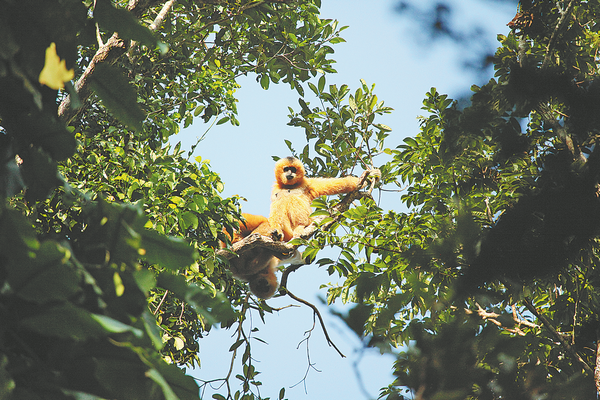

Mi didn't waste time in sharing his excitement with Jiang, who wholeheartedly agreed to the idea. The duo bade farewell to the comforts of urban life and embraced the challenges of living in a jungle.
Nature put them to test from the very beginning. While tagging along with senior rangers in the mountains, Mi was bitten by an insect. "My arm itched, but the bug was too small to be taken seriously. A cardinal mistake," he recalls.
The skin irritation quickly spread and left him with a very painful inflammation. "Lesson learned, I never ignore signs and symptoms now," he adds.
For Jiang, it was a nightmare come true when she fell down a slope and into a pit infested with leeches.
"I came out dizzy and bleeding, covered in wounds, some of which had leeches still attached to them. Just thinking about it makes me shudder," she says.
Far away from the security of city life, Mi and Jiang lost weight. But, as days passed in the wilderness, the couple's survival instincts grew.
They came up with ideas to ward off pesky insects. A piece of cloth dipped in concentrated saltwater and wrapped around the end of a stick became a remedy in case of leech encounters. The salt acted as an active disinfectant and prevented wounds from festering.
It took the couple around four months to fit into the rhythm of things, including forest protection and team management.
"Yes, the conditions were hard, but they made us what we are today," Mi says.
"We are one big family now, helping one another through thick and thin," he adds.
Over the years, Mi and his team have trekked through dangerous mountains and dark woods to capture heartwarming wildlife moments on camera.
Right now, Mi is sorting information on dragonflies.
"It is a joint investigation project with the Chinese Academy of Sciences. An illustrated handbook on the dragonflies of Yinggeling will be published later this year," he says.
Last year, the team conducted butterfly and freshwater fish surveys. "The objective was to collate data for research and conservation," Mi recalls.
Yinggeling is home to a large number of butterfly species, whose population growth mirrors the ecological balance of the area. Freshwater fish too is an important indicator of a rainforest ecosystem, he explains.
It goes without saying that Mi has been a major driving force behind the series of illustrated books published, and documentaries broadcast, on Yinggeling's rich biodiversity.
"We take photographs and make videos during our fieldwork. I figured these could be put to use to make people aware of the need to protect our forests," Mi says.
Since the first bunch of college students walked into Yinggeling for scientific studies in 2007, the rainforest operation has enjoyed a regular infusion of young blood. Promoting research was a part of the local administration's strategies to protect nature and wildlife from commercial logging and poaching. In 2019 alone, the reserve received seven students who dedicated themselves to the development of the Hainan national park.
Years of collective endeavor has finally paid off. Advanced conservation ideas have been promoted among villagers who inhabit the peripheral areas of the rainforest. Hundreds have become rangers, sworn to protect Yinggeling.
Some have learned farming techniques to reduce dependence on forest produce.
Fu Hongjiang, a local villager, has picked up green cash crop planting and beekeeping skills.
"I am planning to scale up production," Fu says.
Mi says he is looking forward to more young people joining his team to stand guard over the mountains and protect the rainforest.
"There are so many species here, and they are all interconnected in ways we are yet to explore," he says. "My colleagues and I have pledged to protect them. We hope our community grows."